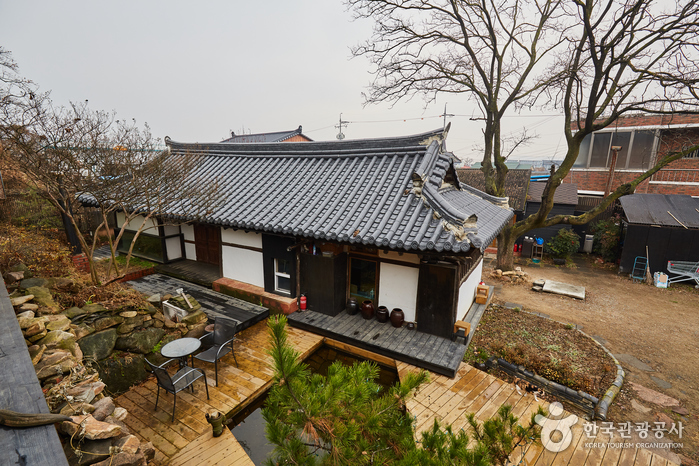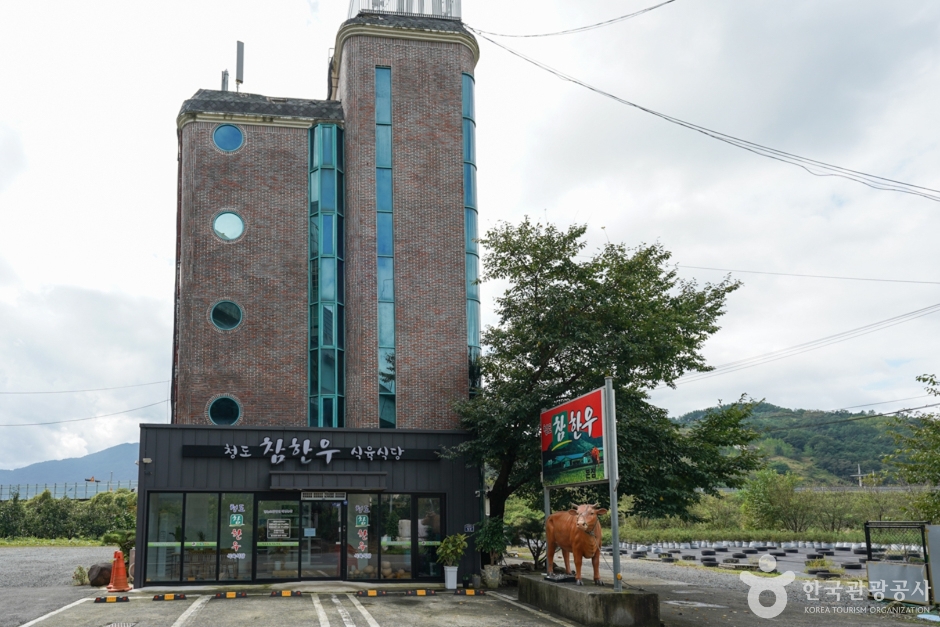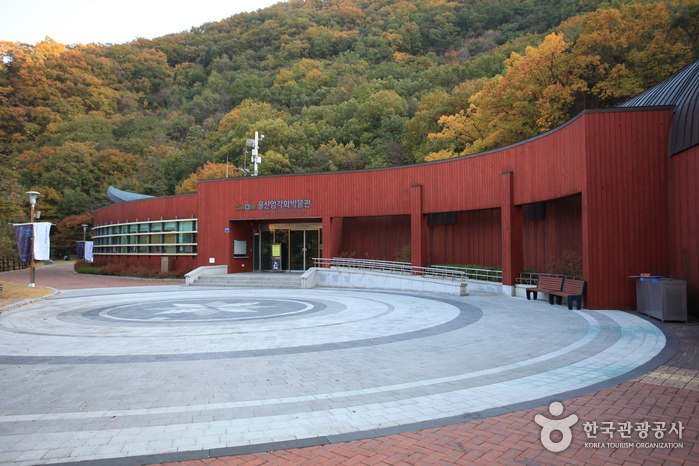Eonyang Giwajip Bulgogi (언양기와집불고기)
17.9Km 2025-03-28
86 Heonnyang-gil, Eonyang-eup, Ulju-gun, Ulsan
* Please be advised that this is located in one of the areas affected by the recent wildfire (as of March 27, 2025).
** For real-time wildfire information and emergency upates, visit the Korea Forestfire Information website and the National Disaster and Safety Portal.
Eonyang Giwajip Bulgogi is a more than 40-year-old establishment housed in a renovated hanok with a history exceeding 100 years. Eonyang bulgogi is crafted by finely mincing beef, seasoning it with various spices, and grilling it on charcoal until it becomes wide and flat. The use of a gridiron for grilling imparts a distinct smoky flavor, and the mild seasoning contributes to a pleasant texture. When wrapped in fresh vegetables alongside pajeori (green onions), the combination produces an outstanding taste. The doenjang jjigae (soybean paste jjigae) and side dishes, known for their subtle seasoning, offer a clean and refreshing taste.
Eonyang Jinmi Bulgogi (언양진미불고기)
18.2Km 2024-02-20
33 Jungpyeong-ro, Samnam-eup, Ulju-gun, Ulsan
Eonyang Jinmi Bulgogi specializes in using Korean beef to create tender and flavorful Jinmi Bulgogi, where the natural taste of the ingredients is preserved. The signature dish features fresh beef topped with plenty of minced garlic, grilled to perfection over charcoal. The rich and well-presented side dishes, including yukhoe (beef tartare), complement the main dish and enhance the overall dining experience. The unique aspect of Eonyang Jinmi Bulgogi is the enjoyment of the dish without broth, grilling the meat on the grid and savoring it with green onion threads.
Asamgong
18.5Km 2021-04-09
5-5, Sawol 1-gil, Namsan-myeon, Gyeongsan-si, Gyeongsangbuk-do
+82-10-2541-1284, +82-10-4787-3314
Located in Sawol-ri, Namsan-myeon, a place known for its beautiful sandy beach, the guesthouse ‘Beautiful Life’ was built by architect Kim Gyeong-ho, and is composed of 100-year-old-hanok buildings and a courtyard with a large sophora. Designed to provide guests with a “beautiful life”, it provides both accommodation services and diverse cultural programs including exhibitions, performances, and movie screenings.
Beautiful Life was conceived as a cultural tourism space set amid quiet countryside where guests can relax by enjoying exhibitions and performances, reading a book, listening to music, or getting lost in thought amid the serene atmosphere of the house. The owner transformed the abandoned house into a beautiful hanok stay after falling under the charm of the quiet location and the old house with its beautiful old tree and well.
The guestrooms include Jewoldang, Yeorakdang, Uiyeoldang, and Heosimjeong. The first of these is a 100-year-old hanok structure with a tiled roof, which can be rented in its entirety. Its name, Jewoldang, roughly means “a place to pick up the moon” because the moon is visible above the sephora in the courtyard from the daecheong (wooden floor) on bright moonlit nights. Its ‘ㅡ’-shaped structure and ceiling rafters are original features of the old hanok, while the kitchen and bathroom were entirely renovated, as was the attic on the second floor, lending a special atmosphere to the house.
As for the Yeorakdang, which means ‘a house to enjoy together,’ it was converted from a storeroom for apples into a building that can accommodate groups of guests and also screen movies. The Uiyeoldang, meaning ‘a house to discuss and study together,’ was built by transforming the haengrangchae (servants’ quarters) and the stable into a reading space and a seminar room, respectively. Finally, the Heosimjeong, meaning ‘a pavilion where one can empty one’s mind’, is the ideal place for relaxing in small groups. Each of these four buildings is built in a modern style with wooden materials, glass windows, and staircases. There is also an outdoor stage equipped with a sound system for special performances.
Cheongdo Chamhanwoo Meat Restaurant (청도참한우식육식당)
19.1Km 2024-02-13
21-1 Dongseobuk 14-gil, Masanhappo-gu, Changwon-si, Gyeongsangnam-do
054-373-9898
Situated close to Cheongdo Station, Cheongdo Chamhanwoo Meat Restaurant is renowned for its expertise in beef dishes. Its signature offering is the hanu special (Korean beef special), a delightful combination that includes galbitsal (grilled boneless galbi) and salchisal (chuck flap tail). The fresh meat is expertly grilled on a stone plate, enhancing its flavors. Pairing it with myeonginamul (a salad made with victory onion sourced from Ulleungdo Island) adds a unique and rich taste to the meal. Other highly recommended dishes at the restaurant are kkotdeungsim (ribeye) and yukhoe (beef tartare).
Ulsan Daegok Museum (울산대곡박물관)
19.1Km 2021-05-18
257, Seohacheonjeon-ro, Ulju-gun, Ulsan
+82-52-229-4787
Ulsan Daegok Museum displays artifacts that were uncovered from the area of Daegok-ri during the construction of Daegok Dam. Approximately 13,000 relics were excavated during land inspection prior to the dam construction, including Hasamjeong Ancient Tomb. These findings were collected and became available for public display when the museum opened on June 24, 2009.
Ulsan Petroglyph Museum (울산암각화박물관)
19.6Km 2021-02-22
254, Bangudaean-gil, Ulju-gun, Ulsan
+82-52-229-4797
Ulsan Petroglyph Museum was established on May 30, 2008 at the entrance to Petroglyphs of Bangudae Terrace (National Treasure No. 285) in Ulju-gun. The museum displays 311 exhibit materials and has an exhibition hall, a storage room, a research lab, and an audiovisual room.
The exhibition hall presents models of petroglyphs of Bangudae and petroglyphs of Cheonjeon-ri (National Treasure No. 147), an educational video introducing the petroglyphs, a children’s hall, and family activity facilities. Visitors can observe reproductions of famous petroglyphs at the outdoor exhibit.
Petroglyphs of Cheonjeon-ri [UNESCO World Heritage] (울주 천전리 명문과 암각화 [유네스코 세계유산])
20.0Km 2025-07-18
Cheonjeon-ri, Dudong-myeon, Ulju-gun, Ulsan
The petroglyphs (figures, pictures, and letters were made on the rocks along the mid-stream area of Naegokcheon Stream, which is a tributary of Taehwagang River. The upper and lower sides of the rocks contain petroglyphs that differ in the content and techniques used. The upper side contains petroglyphs made by means of chiseling. The inscriptions include geometric patterns, animals, and abstract human figures. There are concentric circles, with a round figure looking like the sun at the center, four running deer next to them, and several semi-human animals. The figures with simplistic expression and symbolism appear to have been made during the Bronze Age.
The lower side contains line-drawn picture mixed with Chinese characters. They include a procession of horse riders, animals including dragons, and boats. In particular, the procession of horse riders appears in three different places. The boats provide researchers with important information on the offshore activities carried out by people of the Silla dynasty. The 800-plus written characters are about the King and Queen’s visit to the place. They were presumed to have been inscribed on two occasions during the reign of King Beopheung (r. 514-540) of the Silla dynasty. The content on the official positions and the government system makes it a precious material for those studying Silla during or around the 6th Century. The petroglyphs were made by many people over an extended period of time, providing vivid information on the life and thoughts of people from prehistoric times to the Silla dynasty.
The petroglyphs in Cheonjeon-ri and petroglyphs on the Bangudae Terrace, spanning three kilometers altogether along the Bangucheon Stream, have been inscribed on the UNESCO World Heritage List on July 12, 2025.
(Source: Korea Heritage Service)




![Petroglyphs of Cheonjeon-ri [UNESCO World Heritage] (울주 천전리 명문과 암각화 [유네스코 세계유산])](http://tong.visitkorea.or.kr/cms/resource/14/3335114_image2_1.jpg)
 English
English
 한국어
한국어 日本語
日本語 中文(简体)
中文(简体) Deutsch
Deutsch Français
Français Español
Español Русский
Русский